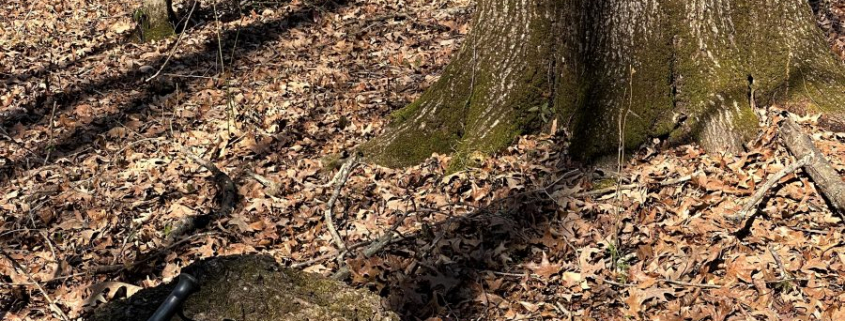A New (for me) Tree Growth Phenomenon
I’ll begin this Post with the teaser photograph immediately below, offering it without explanatory text, which you’ll see after the A First Time Encounter heading.
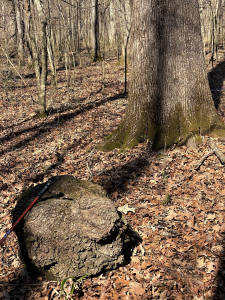
A forester, I’ve long found fascination in tree form… whether the veneer-quality cherrybark oak below left, or the distorted, burly Bigfoot oak below right. I’ve included these photos in previous Posts. So, I won’t include any location or explanatory text. My real intent is to lead to revealing more about the unique curiosity in the photo above.
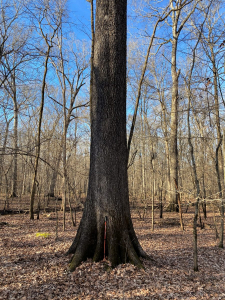
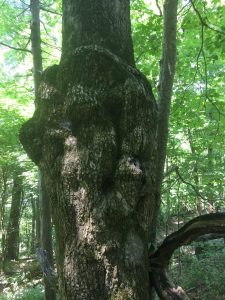
Common Oddities on Living Trees
The two photos above capture the range of tree form I’ve encountered across my Alabama forest wanderings, and that I have discussed in prior Posts. These two curiosities below result from non-fatal viral or fungal infections and the resultant growth abnormalities.
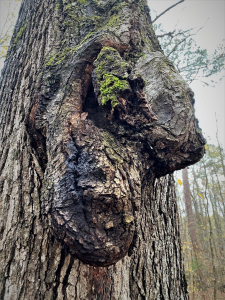
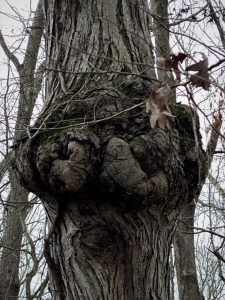
As does this odd form associated with a broken and now calloused-over branch stub.
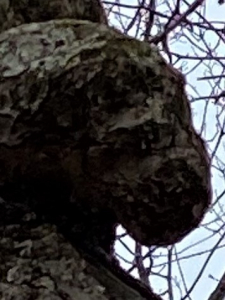
And, this curiosity originated with a severed (e.g., wind breakage) companion bole (a twin stem), which left an infection court (the wound) for decay fungi that are actively hollowing the trunk and misshaping the base.
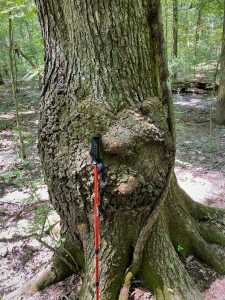
I now have a full portfolio of odd tree forms and curiosities, including the spherical two-foot diameter burl below left and the primitive spirit face below right. Both are viral or fungal-triggered growth abnormalities.
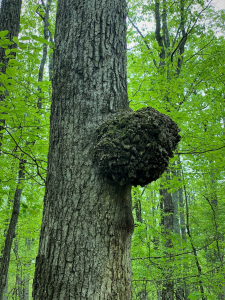
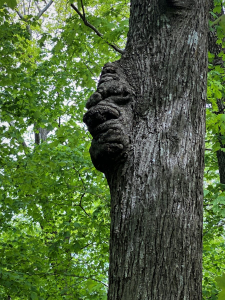
Less Common Curiosities
Root grafts with an adjacent living tree of the same species maintain active growth in the remaining rind of this yellow poplar stump, which is root-grafted to a large and vibrant yellow poplar tree just off-camera. The pole-sized (12-inch root collar diameter) trunk fell long enough ago that even its decaying remains are no longer present.
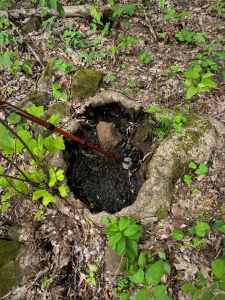
This poplar lost its twin fork (again, wind?) likely decades previous. The raw wound continues to callous and within another decade the scar will have closed. Decay fungi are nearly certain to be consuming interior wood.
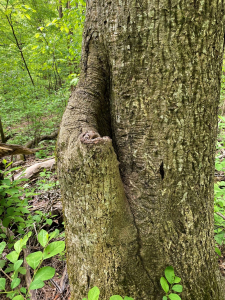
These two beech stumps (eight and twelve inches diameter, respectively) enjoy root grafts with a mature beech nearby.
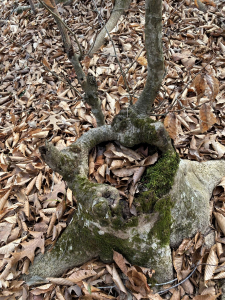
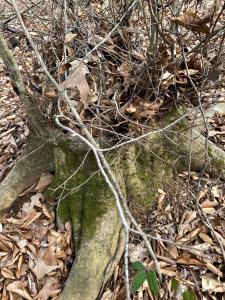
Some in our contemporary popular literature attribute such oddities to a caring and nurturing parent tree, one that shows love and compassion for the unfortunate smaller neighbor. I say “rubbish.” Physical contact (above or below ground) of like species often results in a grafted union. I simply will not accept that such union has its basis in affection, love, emotional embrace or any form of tree-attributed anthropomorphism. In this case, the larger neighbor feels no sense of commitment, obligation, or adoptive spirit for the still-living stump. Instead, I believe that the reasons and explanations are physiological.
The plant physiology literature continues to explore the mechanism and its underlying evolutionary advantages. For example, some have postulated about the advantage to the vibrant living beech-neighbor via its grafted root-union with the above two stump-trees. Here’s my own assessment. By grafting to roots of the two stump-trees, the vibrant survivor now taps soil resources (water, nutrients, soil aeration) accessed and gathered from both its own original roots as well as the root system of the two stump-trees. I don’t buy the mother-love emotion rationale. So, rather than an act of commensalism (mutually advantageous partnership), the larger tree has out-competed the smaller (weaker) individuals, accelerating their demise… and now, via the graft union, the victor has appropriated the victims’ roots for its own purposes. All is fair in love and war… and, this is brutal combat. Love and peace are a myth among trees competing for scarce resources. Simply, to the victor go the spoils. Another iteration of Darwin’s survival of the fittest.
A First-Time Encounter
I have previously seen all of the examples above in my five decades of forest wanderings… some more frequently than others, but none have I seen rarely enough for me to dedicate an entire Post to its revelation and discussion. However, this one that I encountered February 24, 2021, within the bottomland hardwood forests on the eastern end of Wheeler National Wildlife Refuge spurred this Blog Post. The trunk and the 30x30x30″ cube are southern red oak. This adjacent growth anomaly brought to mind a piece of furniture lying on the forest floor, a portable barked-artifact that could be moved and repositioned. However, rest assured, it is securely anchored. I believe that, like the two beech stumps, this table owes its origin to a broken stump with roots grafted to the surviving southern red oak tree.

I offer four quarter-views to complete the 360 perspective. I feel somewhat like the magician giving a full-round view of the box his assistant has just entered… after he has closed the lid and before he begins sawing the container into two halves. I don’t want the reader to think I have hidden some secret facet of this forest anomaly.
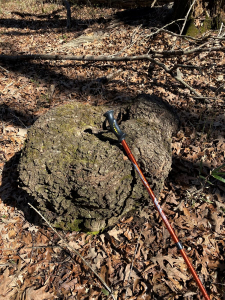
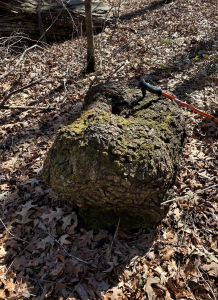
I examined it time and again, marveling at its mystery.
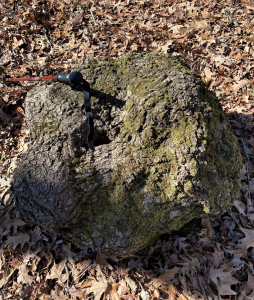
Yet, isn’t almost everything in Nature a mystery of sorts? I recently found an apt Albert Einstein quote: It’s not that one thing is a miracle, but that the whole thing is a miracle. If not a miracle, then certainly a wonder, just one more element of Nature’s capacity to intrigue, inspire, and lift us. This barked-table…this astounding growth abnormality…falls within Nature’s trick-bag, her infinite reservoir of magic that stirs my imagination and stimulates the forest scientist within me to ponder and seek to understand.
I know from both my science discipline and my lifelong Nature addiction that nothing she presents should surprise me. Leonardo da Vinci observed 500 years ago:
While human ingenuity may devise various inventions to the same ends, it will never devise anything more beautiful, nor more simple, nor more to the purpose than nature does, because in her inventions nothing is lacking and nothing is superfluous.
Although this particular curiosity puzzles me, I know that the effect falls within Nature’s own laws. Again, da Vinci:
Necessity is the theme and the inventress, the eternal curb and law of nature. Nature never breaks her own laws.
As I’ve written many times during the frequent occasions when I’ve pondered Nature’s causes and effects, I’ve often wished I could travel back in time in decadal increments, returning to the series of events leading to creating phenomenon like this barked-table anomaly.
Thoughts and Reflections
I offer three observations from contemplating Nature’s odd handiwork:
- Nature’s capacity to intrigue and inspire is without limit
- Grand mystery awaits the observant student of Nature
- The noblest pleasure is the joy of understanding Nature
Inhale and absorb Nature’s elixir. May Nature Inspire, Inform, Humble, and Reward you!
Note: All blog post images created & photographed by Stephen B. Jones unless otherwise noted. Please circulate images with photo credit: “©2021 Steve Jones, Great Blue Heron LLC. All Rights Reserved.”
Another Note: If you came to this post via a Facebook posting or by an another route, please sign up now (no cost… no obligation) to receive my Blog Post email alerts: http://eepurl.com/cKLJdL
And a Third: I am available for Nature-Inspired Speaking, Writing, and Consulting — contact me at steve.jones.0524@gmail.com
Reminder of my Personal and Professional Purpose, Passion, and Cause
If only more of us viewed our precious environment through the filters I employ. If only my mission and vision could be multiplied untold orders of magnitude:
Mission: Employ writing and speaking to educate, inspire, and enable readers and listeners to understand, appreciate, and enjoy Nature… and accept and practice Earth Stewardship.
Vision:
- People of all ages will pay greater attention to and engage more regularly with Nature… and will accept and practice informed and responsible Earth Stewardship.
- They will see their relationship to our natural world with new eyes… and will understand more clearly their Earth home.
Tagline/Motto: Steve (Great Blue Heron) encourages and seeks a better tomorrow through Nature-Inspired Living!
Steve’s Three Books
I wrote my books Nature Based Leadership (2016), Nature-Inspired Learning and Leading (2017), and Weaned Seals and Snowy Summits: Stories of Passion for Place and Everyday Nature (2019; co-authored with Dr. Jennifer Wilhoit) to encourage all citizens to recognize and appreciate that every lesson for living, learning, serving, and leading is either written indelibly in or is powerfully inspired by Nature.
I began writing books and Posts for several reasons:
- I love hiking and exploring in Nature
- I see images I want to (and do) capture with my trusty iPhone camera
- I enjoy explaining those images — an educator at heart
- I don’t play golf!
- I actually do love writing — it’s the hobby I never needed when my career consumed me
- Judy suggested my writing is in large measure my legacy to our two kids, our five grand kids, and all the unborn generations beyond
- And finally, perhaps my books and Blogs could reach beyond family and touch a few other lives… sow some seeds for the future


All three of my books (Nature Based Leadership; Nature-Inspired Learning and Leading; Weaned Seals and Snowy Summits) present compilations of personal experiences expressing my (and co-author Dr. Wilhoit for Weaned Seals and Snowy Summits) deep passion for Nature. All three books offer observations and reflections on my relationship to the natural world… and the broader implications for society. Order any and all from your local indie bookstore, or find them on IndieBound or other online sources such as Amazon and LifeRich.

